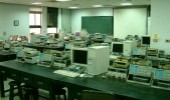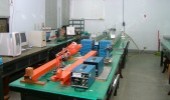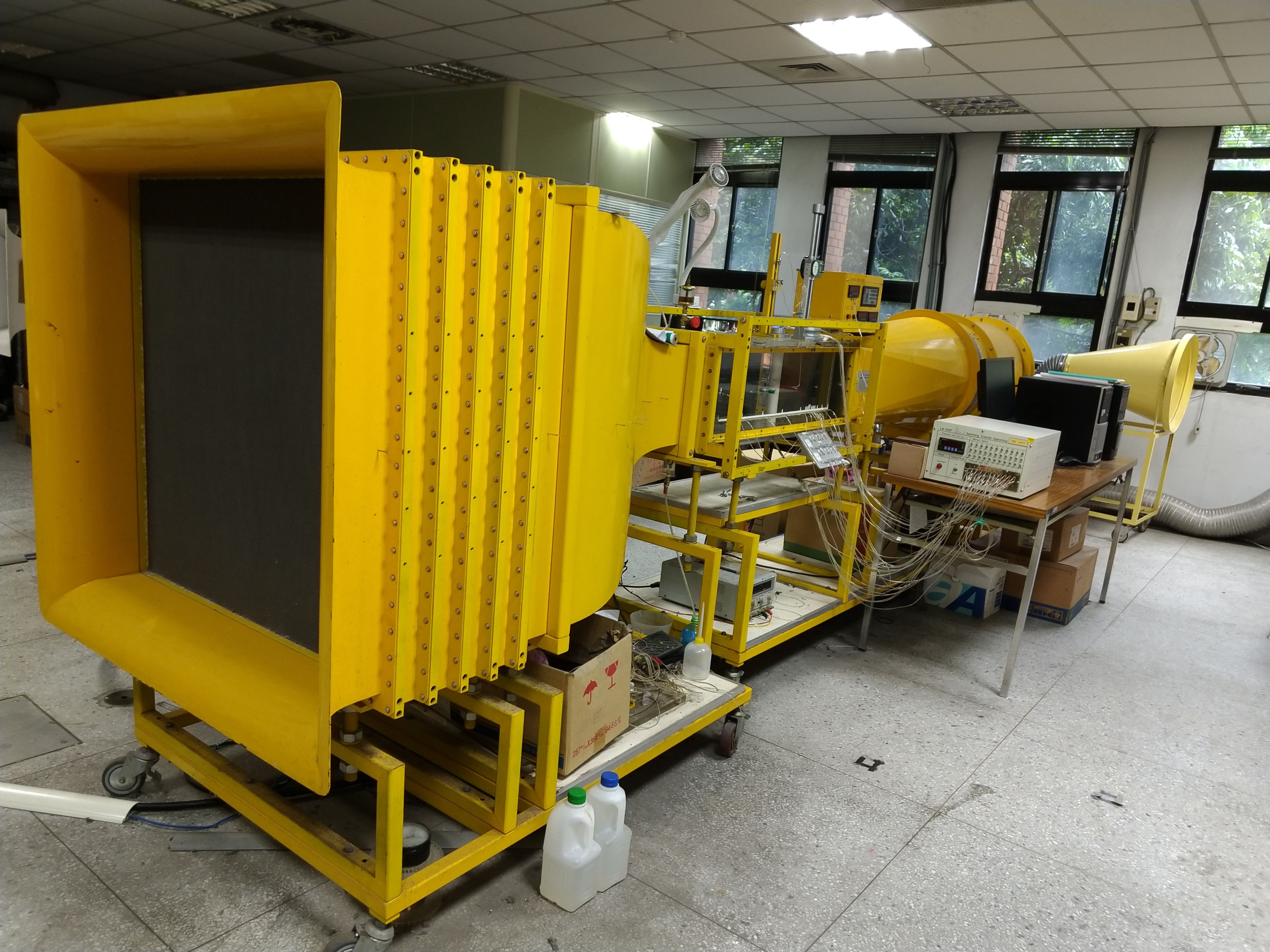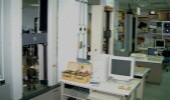流體力學實驗室
Electronics Laboratory
Electronics Laboratory
Lab 0: Introduction to the Course and Instruments
Dual Trace Oscilloscope
Function Generator
DC Power Supply
Digital Multimeter
Lab 1: DC Circuits and Capacitors
Ohm’s Law
Voltage Divider
RC Circuit
Low-pass Filter
High-pass Filter
Filter Application
LC Filter
Lab 2: Diode Circuits
The Diode
LC Resonant Circuit
Rectifier Circuits
Diode Clamp
Diode Limiter
Lab 3: Bipolar Transistors
Transistor Junctions are Diodes
Emitter Follower
Input and Output Impedance of Follower
Single-Supply Follower
Transistor Current Gain
Current Source
Common-emitter Amplifier
Emitter Follower Buffer
Transistor Switch
Lab 4: Field-Effect Transistors
FET Characteristics
FET Current Sources
Source Follower
FET as Variable Resistor
Lab 5: Operational Amplifier I: Idealized View
Open-Loop Test Circuit
Inverting Amplifier
Non-inverting Amplifier
Follower
Current Source
Current to Voltage Converter
Summing Amplifier,
Push-pull Buffer
Lab 6: Operational Amplifier III: Positive Feedback, Good and Bad
Two Comparators
RC Oscillator
555 IC Oscillator
Sawtooth Oscillator
Triangle Oscillator,
Sine Wave Oscillator: Wien Bridge
Follower: Op Amp Instability
Lab 7: Voltage Regulators
The 723 Regulator
Three Terminal Fixed Regulator
Adjustable Three-terminal
Regulator: 317
Voltage References
”Crowbar” overvoltage protection
Integrators
Differentiators
Lab 8: Digital Gates
Input & Output Characteristics of Integrated Gates: TTL & CMOS
Applying NANDs to Generate Particular Logic Functions
Two Inverters
CMOS NAND
\CMOS Three-State
Lab 9: Flip Flops
A primitive flip-flop: NAND Latch
D Type
J-K Type,
J-K in Counters
Shift Register
7490 Decade Counter
7447 BCD to 7 Segment Decoder
Lab 10: A/D and D/A
Weighted-Resistor DAC
R-2R Ladder DAC
DAC0800 8-Bit Digital-To-Analog Converters
ADC0804 8-Bit Analog-To-Digital Converters
ADC-To -DAC Circuit
Research Labs
| Lab Name | Room | Ext. | Advisor | Phone |
| Biomedical Engineering Lab | 008-A | 65662 | Dr. Shau,Yio-Wha | +886-2-3366-5660 |
| Biomimetic Engineering Lab | 008 | 65253 | Dr. Wang, An-Bang | +886-2-3366-5651 |
| Microfluidics Lab | 012 | 65658 | Dr. Wo, Andrew M | +886-2-3366-5656 |
| Biomechanics and Ultrasound Imaging Lab | 013A | Dr. Lin, Che-Yu | +886-2-3366-5653 | |
| Mobile Advanced Storage Technology Lab | 015 | 56019 | Dr. Wu, Kuang-Chong | +886-2-3366-5695 |
| Biomechanical Microsystems Lab | 102 | Dr. Hsu, Yu-Hsiang | +886-2-3366-5607 | |
| Environmental and Energy Devices Lab | 105-A | 69423 | Dr. Chen, Jian-Zhang | +886-2-3366-5694 |
| Vortex Dynamics and Bio-Medical Fluid Mechanics Lab | 106 | 65669 | Dr. Chu, Chin-Chou | +886-2-3366-5668 |
| Advanced Thermal Science and Flow Control Lab | 108 | 65650 | Dr. Wang, An-Bang | +886-2-3366-5651 |
| Nano-Bio Lab | 202 | Dr. Sheen, Horn-Jiunn | +886-2-3366-5632 | |
| Soft Matter and Active Material Lab | 223 | 65543 | Dr. Jiang, Hong-Ren | +886-2-3366-5620 |
| Safety Evaluation Lab | 227 | 65624 | Dr. Liu, Pei-Ling | +886-2-3366-5622 |
| Mechanics of Nano-Materials Lab | 229 | 65680 | Dr. Wu, Kuang-Chong | +886-2-3366-5607 |
| Cerebral Haemodynamics Group | 229 | 65675 | Dr. Stephen Payne | +886-2-3366-5682 |
| Nanophotonics & Metamaterials Lab | 308 | 55006 | Dr. Chern, Ruey-Lin | +886-2-3366-5853 |
| Lithium Battery and Multi-scale Mechanics Lab | 323 | 65689 | Dr. Chen, Kuo-Ching | +886-2-3366-5601 |
| Multi-scale Flow Physics and Computation Lab | 323 | 65689 | Dr. Chou, Yi-Ju | +886-2-3366-5068 |
| Microfluidics and Bio-Sensor Lab | 324 | 65634 | Dr. Sheen, Horn-Jiunn | +886-2-3366-5632 |
| Navigation and Control Lab | 325 | 65685 | Dr. Wang, Li-Sheng | +886-2-3366-5686 |
| Nano and Micro Scale Fluid Mechanics Lab | 326-A | 65674 | Dr. Lei, U | +886-2-3366-5673 |
| Resonant MEMS Lab | 326-B | 65667 | Dr. Li, Wei-Chang | +886-2-3366-5636 |
| Computational Materials Mechanics Lab | 327 | 65665 | Dr. Chen, Chih-Hung | +886-2-3366-5678 |
| Computational Mechanics and Intelligence | 327 | 65665 | Dr. Chou, Chia-Ching | +886-2-3366-5639 |
| Energy and Environmental Fluid Mechanics Lab | 328 | 65690 | Dr. Chen, Falin | +886-2-3366-5692 |
| Biochemical Sensing Systems Lab | 418 | 65625 | Dr. Chen, Chien-Fu | +886-2-3366-5608 |
| Mechanics for Biomedical & Opto-electrical Engineering Lab | 422 | Dr. Chang, Chien-Cheng | +886-2-3366-5672 | |
| Waves and Fracture Mechanics Lab | 426 | 65629 | Dr. Kuo, Mao-Kuen | +886-2-3366-5630 |
| Smart Materials and Energy Harvesting Laboratory | 428 | 65681 | Dr. Shu, Yi-Chung | +886-2-3366-5627 |
| NTU Nano-BioMEMS Group | 433 |
65646 56016~8 |
Dr. Lee, Chih-Kung Dr. Hsu, Yu-Hsiang |
+886-2-3366-5645 +886-2-3366-5652 |
| Nano-BioMEMS Group-Intelligent Sensing Lab (PZGroup) | 433 |
65646 56016~8 |
Dr. Chang, Pei-Zen | +886-2-3366-5652 |
Teaching Labs
The Institute now has four teaching laboratories, one computer room and one machine shop. In addition, the Northern Micro-Electro-Mechanical System (MEMS) Center of Nation Science Council (NSC) is also locate inhouse.
The teaching laboratories consist of the following:
|
Name
|
Photo
|
負責技士
|
聯絡電話
|
|
教學實驗室
|
|||
 |
徐發義
|
+886-2-3366-5612
|
|
 |
林佑思
|
+886-2-3366-5610
|
|
 |
林佑思
|
+886-2-3366-5610
|
|
 |
廖家文
|
+886-2-3366-5609
|
|
|
其他設備
|
|||
 |
陳建兆
|
+886-2-3366-5615
|
|
 |
廖家文
|
+886-2-3366-5609
|
|
Mechanics of Materials Lab

SHIMADZU Universal Testing Machine

Shimadzu Universal Testing Machine with torsion fixtures

Pulsed Ultrasonic Instruments

Photoelasticity
Course Description
Uniaxial Tensile Test
To run tensile tests on two different types of material - Aluminum and Steel bars and obtain the significant mechanical properties from the test results.
Equipment:
- Two different types of material - Aluminum and Steel bars
- Shimadzu Universal Testing Machine Autograph AG-10TA
- Strain gages
- Strain Indicator P-3500
--------------------------------------------------------------------------------------------------
Torsion Test
To familiarize the shear stress-strain relationship of metals in both elastic and plastic ranges.
Equipment:
- Shimadzu Universal Testing Machine Autograph AG-10TA with torsion fixtures
--------------------------------------------------------------------------------------------------
Pulsed Ultrasonic Experiments
The purpose of this experiment is familiarize the student with fundamental of elastic wave propagation and its applications on the characterization of material properties, and flaw structures, … etc ..
Equipment:
- PANAMETRICS Pulser / Receiver 5072 PR
- NI VirtualBench and Personal Computer
- longitudinal and shear wave transducers ( 2.5 MHz )
- Longitudinal and shear wave couplants.
--------------------------------------------------------------------------------------------------
Acoustoelastic Effect in Solids
The purpose of this experiment is to utilize acoustoelastic effect to measure the third order elastic constants of an isotropic material and to realize its application to stress measurement.
Equipment:
- Shimadzu Universal Testing Machine Autograph AG-10TA
- Ultrasonic pulse generator and receiver
- Longitudinal and shear wave transducers ( 5 MHz )
- Oscilloscope and time interval counter
--------------------------------------------------------------------------------------------------
Stress Analysis by Photoelasticity
To demonstrate the unique ability of photoelasticity to visually depict the stress distributions throughout a loaded structure. Further, this method will be used to get quantitative data for these loaded structures.
Equipment:
- Transmitted Light Polariscope
- Camera
Dynamics Lab
Modal testing
- Objectives:
To measure the natural frequencies and vibration modes of a structural system and to understand the vibration concept.
- Equipment:
The experimental system includes an aluminum rod suspended by a pair of soft springs, an accelerometer, an instrumented hammer with a force transducer installed, spectrum analyzer, power supply and amplifier, and a PC based data acquisition system.
--------------------------------------------------------------------------------------------------
Gyroscopic Motion of a Rigid Body
- Objectives:
To study the gyroscopic effects on the motions of a rigid body.
- Equipment:
1. large steel sphere with an attached rod supported by a semispherical seat.
2. compressor to levitate the sphere and to reduce the friction.
3. Stroboscope, stopwatch, ruler.
--------------------------------------------------------------------------------------------------
Calibration of Displacement Sensors
- Objectives:
To study the principles of LVDT, Fotonic and Eddy Current sensors and perform the calibration, data acquisition and analysis.
- Equipment:
LVDT
Eddy current sensor
Fotonic sensor
Proximeter
Dial gauge
Platform
Data acquisition system
Power supplier
--------------------------------------------------------------------------------------------------
Vibrations of Coupled Oscillators
- Objectives:
To study the free and forced motions of two spring-coupled masses.
- Equipment:
A linear air track with requisite springs, gliders, air blower, and driving motor
Power supply
A stop watch
An electro-magnet
Research Fields
Since 1994, the Institute has been gradually diverting the direction from the defense-related research to an interdisciplinary and state-of-the-art research oriented towards world-wide trend and local needs. The new research direction embraces areas in mechanics, nanotechnology, biomechanics, biomedical research, information, and mechatronics. The Institute has further identified three major fields in connection with "Mechanics in Nano-Revolution", namely,
Waves and N/MEMS
Waves and N/MEMS with focus on the analyses and applications of the elastic waves and electromagnetic waves and their interactions.
Nano-Biomechanics
Nano-Biomechanics with focus on the examination of characteristics and interactions of micro- or nano-scale biological structures by mechanics approach.
Multi-Scale Mechanical Systems
Multi-Scale Mechanical Systems with focus on the exploration of the analytic, experimental, and computational aspects of the systems.
Fluid Mechanics Lab
Drag on a circular cylinder
- A Wind-tunnel ( speed-variable )
- One cylinder with a wall-mounted pressure tap
- A Prandtl-tube ( Pitot-static tube)
- A manometer
--------------------------------------------------------------------------------------------------
Thermal anemometry
- A Hot-wire anemometer
- A Hot-wire calibrator (TSI, model 1125) with a compressed air source
- An oscilloscope
- A multimeter
- An U-tube manometer
- A diaphragm manometer
--------------------------------------------------------------------------------------------------
Air jet flows ( circular and planar )
- An axisymmetric vertical jet ( Nozzle diameter = 5 mm )
- An two-dimensional vertical jet ( Exit area = 1 mm x 60 mm )
- A pitot tube for field velocity measurements
- A force plate assembly
--------------------------------------------------------------------------------------------------
Dynamic Similarity
Objectives:
After completion of this experiment and perform the analyses required, you should acquire the following skills:
- Understand the basics of pipe flow, pressure distribution along a pipe, and velocity profile at the pipe exit;
- Measure pressure via water manometer and pitot static probe (to calculate velocity);
- Perform analysis using the Moody diagram;
- Fundamentals of the Buckingham Pi Theorem and dimensionless analysis;
- Uncertainly analysis.
Experimental apparatus:
- A blower fan
- Pipes
- A pitot-static probe
- A water manometer
- Laptop computer (bring your own)
